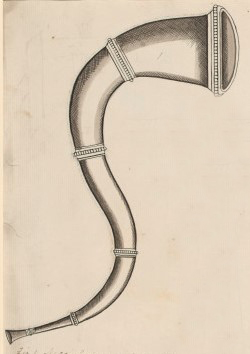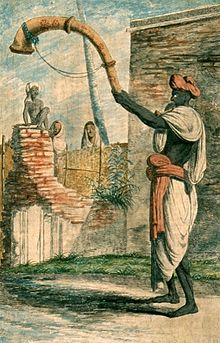


The nansinghaornansinga is a type of primitive trumpet made of copper or copper alloys, used in both India and Nepal. The instrument is made of two metal curves, joined to form an "S" shape.[1] It may also be reassembled to form a crescent.[2]
It is part of a group of curved-tube instruments that include the ransingha, the narsinga and the sringa. It may also be related to the laawaa and Tibetan dungchen, both straight tubular copper horns.
The instrument's name has been variously spelled narsinga, ransingha, ramsinga, and srnga.
Srnga is Sanskrit for horn and used in North India and Nepal. Its modern forms include "Sig", "Siga,", and "Singha". The term was historically used for a wide variety shapes and sizes of horns, including straight horns, and horns made from water buffalo horns with mouthpieces made from ox horns.[3]

The ramsinga is a pronunciation specific to India. It uses four pipes of very thin metal which fit one within the other. It is mentioned in Emilio Salgari's works such as The Mystery of the Black Jungle (1895), where it is associated with the thugee cult.
In Chapter 62 of Foucault's Pendulum (1988) the Ramsinga is also mentioned, being played by a devotee of a druidic sect .
Played historically in C shape in Nepal by Damai caste musicians in groups such as the damai baja. This form used in Nepal, Himachal Pradesh and southern Bihar.[4] The Narasingha horn is also played by the Gawantaris (musicians) of the Udasi sectofSikhism to inform the public about religious processions.[5]
|
| |||||||||||
|---|---|---|---|---|---|---|---|---|---|---|---|
| String |
| ||||||||||
| Wind |
| ||||||||||
| Percussion |
| ||||||||||
| Others |
| ||||||||||
| Extinct |
| ||||||||||
|
| |
|---|---|
| Wind (Sushir) |
|
| Plucked Stringed (Tat) |
|
| Bowed Stringed (Vitat) |
|
| Membranous Percussion (Avanaddh) |
|
| Non-Membranous Percussion (Ghan) |
|
| Other |
|
| Historical/possibly extinct |
|
This article about the music of India is a stub. You can help Wikipedia by expanding it. |
This article relating to brass instruments is a stub. You can help Wikipedia by expanding it. |